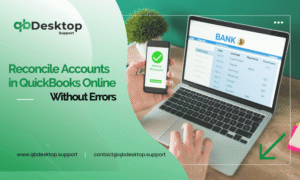QuickBooks Desktop is a powerful accounting software widely used by businesses to manage their finances efficiently. One of its key features is the ability to connect your bank and credit card accounts directly to the software, streamlining the process of tracking expenses, reconciling accounts, and managing cash flow. In this comprehensive guide, we will walk you through the step-by-step process to connect bank and credit cards to QuickBooks Desktop, ensuring smooth integration and accurate financial reporting.
Understanding the Benefits of Connecting Your Accounts
Before diving into the technical aspects of connecting your accounts to QuickBooks Desktop, it’s essential to understand the benefits of doing so. By connecting your bank and credit card accounts, you gain access to real-time financial data, eliminating the need for manual data entry and reducing the risk of errors. This integration also allows for seamless reconciliation of transactions, automatic categorization of expenses, and improved accuracy in financial reporting. Moreover, connecting your accounts saves time and effort, enabling you to focus on strategic business activities rather than administrative tasks.
Preparing to Connect Your Accounts
Before you can connect bank and credit card accounts to QuickBooks Desktop, you need to ensure that you have the necessary information and permissions. Start by gathering the following details:
- Bank and Credit Card Statements: Obtain recent statements for all accounts you wish to connect.
- Online Banking Credentials: You will need your online banking username and password.
- Account Type: Identify whether your account is a checking, savings, or credit card account.
- Account Number: Note down the account number associated with each account.
Additionally, ensure that your QuickBooks Desktop software is up to date with the latest version to ensure compatibility and optimal performance.
Connecting Your Bank Accounts
Now that you have gathered the required information, it’s time to connect your bank accounts to QuickBooks Desktop. Follow these steps:
- Open QuickBooks Desktop and navigate to the Banking menu.
- Select “Bank Feeds” and then “Set Up Bank Feed for an Account.”
- Search for your bank by name or enter the URL provided by your bank for online banking.
- Enter your online banking username and password when prompted.
- Follow the on-screen instructions to complete the authentication process.
- Once authenticated, QuickBooks will display a list of accounts associated with your bank.
- Select the accounts you wish to connect and click “Connect.”
If your bank is not listed, you can manually set up the connection by entering your bank’s name, account type, and routing number. QuickBooks will then guide you through the process of connecting your account using the information provided.
Important Read:- How To Fix Beginning Balance Issues While Reconciling In QuickBooks Desktop?
Connecting Your Credit Cards
Connecting your credit cards to QuickBooks Desktop follows a similar process to connecting bank accounts. Here’s how to do it:
- From the Banking menu, choose “Bank Feeds” and then “Set Up Bank Feed for an Account.”
- Search for your credit card issuer by name or enter the URL for online banking.
- Enter your online banking username and password.
- Follow the on-screen instructions to authenticate your account.
- Once authenticated, select the credit card accounts you wish to connect and click “Connect.”
As with bank accounts, if your credit card issuer is not listed, you can manually set up the connection by entering the required information.
Managing Your Connected Accounts
Now that your bank and credit card accounts are connected to QuickBooks Desktop, it’s important to understand how to manage and utilize this integration effectively. Here are some key tasks:
- Review Transactions: Regularly review transactions imported into QuickBooks to ensure accuracy and completeness.
- Categorize Expenses: Assign appropriate categories to transactions to facilitate accurate financial reporting.
- Reconcile Accounts: Reconcile your bank and credit card accounts regularly to identify discrepancies and ensure accuracy.
- Customize Rules: Create rules in QuickBooks to automatically categorize and match transactions, saving time on manual data entry.
- Monitor Cash Flow: Use QuickBooks’ reporting tools to monitor cash flow and make informed financial decisions.
Troubleshooting Common Issues
While connecting your accounts to QuickBooks Desktop is typically a straightforward process, you may encounter some challenges along the way. Here are some common issues and troubleshooting tips:
- Authentication Errors: If you encounter errors during the authentication process, double-check your online banking credentials and ensure that you are entering them correctly.
- Missing Transactions: If transactions are missing or not importing correctly, verify that your accounts are set up correctly in QuickBooks and that there are no connectivity issues with your bank or credit card issuer.
- Duplicate Transactions: If you notice duplicate transactions in QuickBooks, review your bank and credit card statements to identify any discrepancies and manually delete or merge duplicate entries.
- Unsupported Banks: If your bank or credit card issuer is not supported by QuickBooks, consider exporting transactions manually and importing them into QuickBooks using a supported file format.
Conclusion
Connecting bank and credit cards to QuickBooks Desktop is a fundamental step in optimizing your financial management processes. By harnessing the power of real-time data integration, you can streamline accounting tasks, improve accuracy, and gain valuable insights into your business’s financial health. Follow the step-by-step guide outlined in this article, and you’ll be well on your way to unlocking the full potential of QuickBooks Desktop for your business.
In conclusion, for any further assistance or technical support regarding connecting your bank and credit cards to QuickBooks Desktop, you can contact QB Desktop Customer Support at +1-855-838-5977. Their team of experts is available to provide guidance and resolve any issues you may encounter along the way. Happy accounting!
Frequently Asked Questions
Yes, QuickBooks Desktop allows you to connect multiple bank accounts, including checking, savings, and credit card accounts. You can add each account separately using the Bank Feeds feature.
QuickBooks Desktop uses bank-level security measures to protect your financial data during the connection process. Your online banking credentials are encrypted and stored securely, and QuickBooks does not have access to your username or password.
If your bank or credit card issuer is not listed in QuickBooks, you can manually set up the connection by entering the required information, such as the bank’s name, account type, and routing number. Alternatively, you can export transactions manually from your bank’s website and import them into QuickBooks using a supported file format.
It’s recommended to reconcile your bank and credit card accounts in QuickBooks at least once a month to ensure accuracy and identify any discrepancies. However, you may choose to reconcile more frequently, depending on your business needs and transaction volume.
If you encounter errors during the connection process, such as authentication failures or missing transactions, double-check your online banking credentials and ensure that you are entering them correctly. You can also reach out to QuickBooks Desktop Support at +1-855-838-5977 for assistance and troubleshooting.
Yes, you can disconnect bank and credit card accounts from QuickBooks Desktop at any time. Simply navigate to the Banking menu, select “Bank Feeds,” and choose “Deactivate All Online Services.” Follow the on-screen instructions to disconnect the accounts you no longer wish to have linked to QuickBooks.
No, connecting your bank and credit card accounts to QuickBooks Desktop will not affect your online banking experience. QuickBooks securely retrieves transaction data from your financial institutions without impacting your ability to access your accounts directly through your bank’s website or mobile app.
QuickBooks Desktop does not impose a strict limit on the number of transactions you can import. However, performance may vary depending on the size and complexity of your company file. It’s recommended to monitor your file size and performance regularly to ensure optimal performance.








